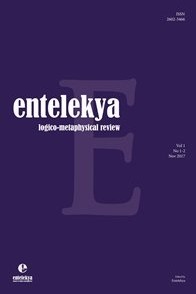Deductions and Reductions Decoding Syllogistic Mnemonics
Deductions and Reductions Decoding Syllogistic Mnemonics
Syllogistic, mnemonics, deduction reduction, Prior Analytics, Robin Smith,
___
- Aristotle. Prior Analytics. Trans. Robin Smith. Indianapolis: Hackett Publishing Company, 1989.
- Aristotle. Prior Analytics Book I. Trans. Gisela Striker. Oxford: Oxford University Press, 2009.
- Bocheński, Joseph. History of Formal Logic. Trans. Ivo Thomas. Notre Dame: University of Notre Dame Press, 1961.
- Cohen, Morris and Ernest Nagel. Introduction to Logic. Ed. John Corcoran. Indianapolis: Hackett Publishing Company, 1993.
- Corcoran, John and Idris Samawi Hamid. “Investigating Knowledge and Opinion.” The Road to Universal Logic: Festschrift for 50th Birthday of Jean-Yves Béziau, vol. I. Eds. Arnold Koslow and Arthur Buchsbaum. Dordrecht: Springer, 2014: 95-125.
- Corcoran, John and Kevin Tracy. “Review of Joray, Pierre, ‘A Completed System for Robin Smith's Incomplete Ecthetic Syllogistic’,” Mathematical Reviews, MR3681098, 2018.
- Corcoran, John. “Argumentations and Logic.” Argumentation 3, 1989: 17-43.
- Corcoran, John. “Aristotle’s Prototype Rule-Based Underlying Logic.” Logica Universalis 12, no. 1-2, 2018: 9-35.
- Corcoran, John. “Aristotle's Demonstrative Logic.” History and Philosophy of Logic 30, 2009: 1-20.
- Corcoran, John. “Deduction and Reduction: Two Proof-Theoretic Processes in Prior Analytics I.” Journal of Symbolic Logic 48, 1983: 906
- Corcoran, John. “Completeness of an Ancient Logic.” Journal of Symbolic Logic 37, 1972: 696-702.
- De Morgan, Augustus. Formal Logic or The Calculus of Inference, Necessary and Probable. London: Taylor and Walton, 1847.
- De Rijk, Lambertus Marie. Logica Modernorum, vol. I. Assen: Koninklijke Van Gorcum & Company, 1962.
- De Rijk, Lambertus Marie. Logica Modernorum, vol. II. Assen: Koninklijke Van Gorcum & Company, 1967.
- Eaton, Ralph. General Logic: An Introductory Survey. London: Charles Scribners' Sons, 1931.
- Jevons, W. Stanley. Elementary Lessons in Logic: Deductive and Inductive. London: Macmillan, 1870.
- Keynes, John Neville. Studies and Exercises in Formal Logic. London: Macmillan & Co., 1906.
- Kneale, William and Mary Kneale. Development of Logic. London: Clarendon Press, 1962.
- Łukasiewicz, Jan. Aristotle's Syllogistic: From the Standpoint of Modern Formal Logic. London: Clarendon Press, 1951.
- Parsons, Terence. Articulating Medieval Logic. Oxford: Oxford University Press, 2014.
- Peirce, Charles Sanders. Writings of Charles S. Peirce: Chronological Edition. Volume 5 (1884-1886). Eds. Nathan Houser et al. Bloomington: Indiana University Press, 1993.
- Rini, Adriane. “Aristotle’s Logic.” The History of Philosophical and Formal Logic: From Aristotle to Tarski. Eds. Alex Malpass and Marianna Antonutti Marfori. London: Bloomsbury Academic, 2017: 29-49.
- William of Sherwood. Manuscript of Introduction to Logic. Paris: Bibliothèque Nationale MS. Lat. 16617, more briefly, BN 16617.
- William of Sherwood. William of Sherwood’s Introduction to Logic. Trans. Norman Kretzmann. Minneapolis: University of Minnesota Press, 1966.
- Başlangıç: 2017
- Yayıncı: İlyas ALTUNER
Zwei Aspekte der Freiheit in Kants Praktischer Philosophie
Being and Intellect: Theory of Demonstration in Aristotle and al-Fārābī by A. Tekin
An Ontological Analysis of Hitler’s Anti-Semitic Perspective
Deductions and Reductions Decoding Syllogistic Mnemonics
John CORCORAN, Daniel NOVOTNÝ, Kevin TRACY
Polis: An Introduction to the Ancient Greek City-State by M. H. Hansen
